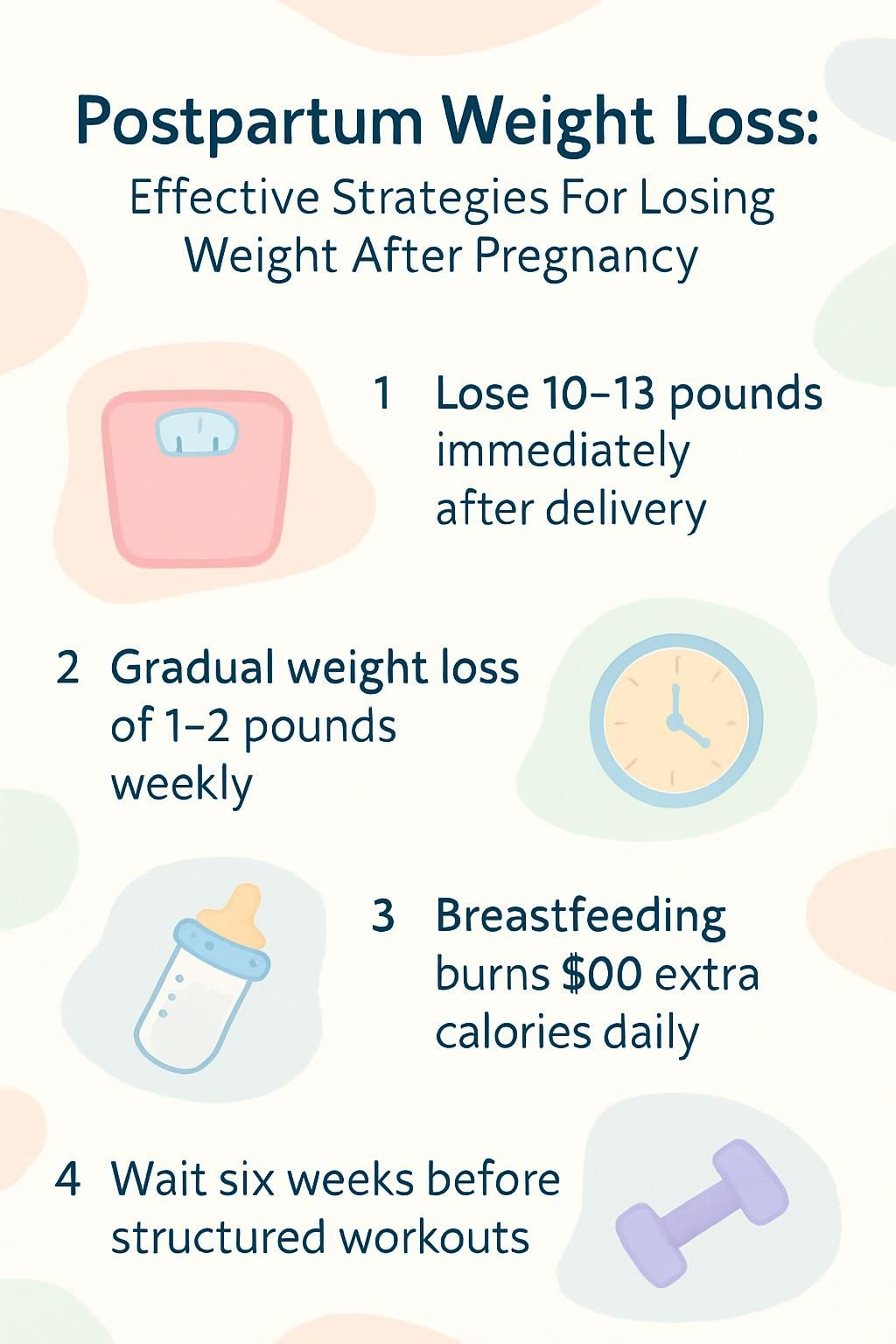Postpartum Weight Loss: Effective Strategies For Losing Weight After Pregnancy
Our Nutrition Assistant AI Suite will transform your body. You will lose fat, get toned, and build muscle. Gain confidence and optimal health.
If you are struggling to lose weight after pregnancy, you are not alone. Postpartum weight loss is gradual for most people. The average person loses about 10 to 13 pounds right after delivery, which comes from the baby, placenta, and amniotic fluid.
This guide walks you through safe, proven steps to help you manage baby weight while you adjust to life with your newborn. You will learn how smart nutrition, gentle movement, and small daily habits add up over time. The aim is progress that fits real life, not perfection.
Keep reading for practical steps you can use today.
Key Takeaways
- Many people lose 10 to 13 pounds right after delivery, then another 4 to 5 pounds in the first weeks as fluid leaves the body.
- Gradual change works best. Health experts suggest losing 1 to 2 pounds per week with balanced meals, portion control, and regular exercise.
- Breastfeeding often burns about 500 extra calories per day. Over six months, it may help use 5 to 6 pounds of stored fat.
- Most clinicians advise waiting until the six-week postpartum checkup before structured workouts. After a C-section, high-impact activity often waits about 12 weeks.
- Support groups, self-monitoring, stress control, good sleep, and professional guidance help long-term success (Smith et al., Journal of Maternal Health, 2021).

Understanding Postpartum Weight Loss

Postpartum weight loss follows a pattern, but the pace differs for each person. Your delivery type, feeding plan, and healing timeline all affect change on the scale.
What is postpartum weight loss?
Postpartum weight loss is the gradual loss of pregnancy weight after childbirth. Right after delivery, the baby, placenta, and amniotic fluid account for about 10 to 13 pounds. Over the next few weeks, you typically shed 4 to 5 more pounds as your body releases extra fluid.
During pregnancy, most people gain about 24 to 30 pounds. How quickly you return to your pre-pregnancy weight depends on your pre-pregnancy body mass index, total weight gained during pregnancy, breastfeeding, sleep, and your recovery process. At hospitals such as Newton-Wellesley Hospital, many patients report that some extra weight remains for months even with healthy eating and regular walks. That pattern is common and normal.
Knowing typical ranges can help you set goals that protect your health and protect your energy.
What factors affect weight loss after pregnancy?
Your delivery method influences your timeline. A C-section often requires more healing time than a vaginal birth, so exercise usually restarts later. Core tissues and pelvic floor muscles need time to recover before activity increases.
Your daily movement and eating plan also matter. Nutrient-dense meals and sensible portions help you reduce pounds gained during pregnancy. Breastfeeding can help you burn extra calories, often using 5 to 6 pounds of stored fat in the first six months. Most professionals advise losing no more than 1 to 2 pounds per week to protect health and, if feeding, milk supply.
It took months to gain the weight. Give yourself at least that long, and often longer, to lose it safely.
Pre-pregnancy BMI, sleep, stress, and any conditions such as gestational diabetes can influence the pace. Patience keeps you consistent while your body heals.
How Can I Set Realistic Weight Loss Goals After Pregnancy?
Clear, patient goals make it easier to track progress and adjust your plan. A simple target, like adding two brisk walks per week, beats a strict plan you cannot maintain.
Why is patience important for postpartum weight loss?
Your body needs recovery time after birth. Hormones shift for months. Many people lose weight at a steady rate in the first six months, then progress slows. It may take nine months, sometimes a year, to approach pre-pregnancy weight.
Comparisons create stress and do not reflect your health needs. Crash diets and extreme workouts raise injury risk and can reduce milk supply. Slow, consistent changes support your energy, mood, and healing.
Set weekly goals you can meet, like preparing three balanced dinners or walking after two feedings. Small wins fuel motivation.
What are typical postpartum weight loss expectations?
Expect an early drop of about 11 to 13 pounds from delivery, followed by 4 to 5 pounds in the first few weeks as fluids leave. If you gained 24 to 30 pounds, these changes cover part of the total gain.
Breastfeeding may help use stored fat over time. Some people see 5 to 6 pounds of fat loss in the first six months, assuming adequate calorie intake and activity. If you are more than six pounds above the healthy adult BMI range of 18.5 to 24.9, a mix of balanced meals and light movement usually helps. Simple habits, such as daily stroller walks and choosing high-protein snacks, often beat a very-low-calorie diet or fad diet.
The scale may move slowly. Nourish well, rest well, and add gentle movement. That approach stays with you.
How Does Breastfeeding Affect Weight Loss?
Breastfeeding increases your calorie needs. For many, it helps weight loss. The effect depends on your feeding pattern, your diet, sleep, and overall activity.
How many calories does breastfeeding burn?
Exclusive breastfeeding often uses about 500 extra calories per day. That energy comes in part from stored fat, which can help weight loss after pregnancy. Feeding for more than three months is linked with modestly greater loss for some people.
Across the first six months, milk production may help reduce 5 to 6 pounds of stored fat. You still need balanced nutrition. Strict dieting can reduce milk supply and energy.
What nutrition should I focus on while breastfeeding?
Hydration matters. Aim to add 5 to 8 cups, 1183 mL to 1893 mL, of non-caffeinated drinks daily. A glass of water, milk, or juice at each feed helps both hydration and milk production.
If you drink alcohol, wait at least two hours before breastfeeding. Continue your prenatal vitamin until the bottle is finished. Choose nutrient-dense foods like whole grains, lean proteins, vegetables, fruit, and low-fat dairy. People who could become pregnant should include 0.4 mg, 400 mcg, of folic acid daily to reduce the risk of neural tube defects.
As feeds decrease, your calorie needs decline. Adjust portions to avoid a plateau.
When and How Should I Start Exercising After Delivery?
Begin with gentle movement and listen to your body. Early motion supports mood, circulation, and healing.
When is it safe to begin postpartum workouts?
Most clinicians recommend waiting for your six-week postpartum checkup before starting structured workouts. After an uncomplicated vaginal birth, short walks and gentle stretching may start earlier if your provider agrees.
If you had a C-section, allow more time. Your abdomen and pelvis need to heal before adding intensity. Light walking supports circulation and can lift your mood. Start with low-intensity options, such as brief walks and simple pelvic floor work, if cleared by your provider. Increase slowly and stop any activity that causes pain, bleeding, or pressure.
What exercise tips should I follow after a C-section?
Wait about 12 weeks before high-impact workouts, running, or heavy lifting. Begin with easy walks and gentle range-of-motion moves. Ask your clinician before starting core training or Kegel exercises. Separation of the abdominal muscles, called diastasis recti, is common after surgery.
Use short sessions that do not strain your abdomen. Some people add light Kegels around two months, if cleared. Many providers delay squats with added weight and resistance training until 16 weeks. Early patience helps prevent setbacks like uterine prolapse and supports a stronger return later.
What Are the Best Postpartum Workouts?
Safe workouts rebuild strength, protect your core, and support a healthy weight. Gentle does not mean easy. Consistency is the key.
How can walking and low-impact cardio help?
Walking, swimming, and water aerobics are joint-friendly and effective. Many experts suggest starting these once postpartum bleeding stops, often around 4 to 6 weeks, with your provider’s approval.
Move 5 to 6 days per week if possible. Keep your heart rate near 60 percent of maximum, which is 220 minus your age, then multiply by 0.60. If time is tight, do three 10-minute sessions. They can match one longer workout.
Short neighborhood walks with a stroller can raise energy and burn calories. Low-impact cardio also supports mood and cardiovascular health during the postpartum period.
Why include strength training and resistance exercises?
Strength training helps rebuild muscle lost during pregnancy. Muscle tissue burns more calories than fat. Bodyweight squats, bridges, pelvic tilts, and leg extensions are good starting options.
You can also use your baby’s weight for simple moves at home. Research reviews show that combining cardio with strength work improves weight management after pregnancy. Stronger muscles support posture, reduce back pain, and lower long-term risks for obesity, type 2 diabetes, and cardiovascular disease.
Increase your total exercise time by 5 to 10 minutes every week or two as energy allows. Slow and steady progress helps you stay consistent.
How do I strengthen my core and pelvic floor postpartum?
Begin with diaphragmatic breathing. Lie on your back, one hand on your chest and the other on your belly. Inhale through your nose, then exhale through your mouth. Do this for 5 to 10 minutes, two or three times a day.
When cleared, add bird dogs, bridges, pelvic tilts, knee lifts, and gentle planks. For Kegel exercises, tighten pelvic floor muscles for three seconds, then relax for three seconds. Aim for three sets of 10 to 15 reps each day. These moves build support, reduce pressure, and improve comfort during daily tasks.
If you see signs of diastasis recti, such as a ridge down the midline or lasting core weakness, talk with your clinician. Physical therapy can help. Surgery is uncommon and reserved for cases that do not improve over time.
Which Workouts Should I Avoid After Giving Birth?
Some exercises strain healing tissues. Skipping them for now protects your abdomen and pelvic floor.
Why avoid high-intensity workouts postpartum?
High-intensity exercise loads your core and joints before they are ready. Most providers suggest waiting at least six weeks after a vaginal birth before intense cardio, heavy lifting, or running. After a C-section, wait longer.
Starting too soon can slow healing and raise injury risk. Focus on low-impact movement instead. You will still make progress, and you will protect your recovery.
Which exercises strain the abdomen and should be avoided?
Sit-ups, traditional crunches, and bicycle crunches increase abdominal pressure. Certain yoga or Pilates moves, like deep backbends or full pushups, also stress the core early on. Even heavy household chores, like vigorous vacuuming, can challenge healing tissues.
Many experts recommend avoiding these for at least six weeks after a vaginal birth and 12 weeks after a C-section. Choose gentle walking and restorative stretching until your provider clears you for more.
What Nutritional Choices Support Postpartum Weight Loss?
Food is fuel for healing. A balanced postpartum diet supports energy, milk production if breastfeeding, and steady weight loss.
Which nutrient-dense foods aid recovery?
Build meals with lean protein such as chicken, fish, beans, or tofu. Pair them with whole grains like brown rice or quinoa for steady energy. Add plenty of vegetables and fruit for vitamins, minerals, and fiber.
If you receive WIC benefits, choose items that fit these goals. Limit added sugar and sweetened drinks to support blood sugar control. Thoughtful nutrition powers your workouts and helps each healthy habit stick.
How important is hydration after pregnancy?
Hydration supports milk production, circulation, and tissue repair. Add 5 to 8 cups, 1183 mL to 1893 mL, of non-caffeinated fluids each day. A drink at every feed can make this easy.
Well-hydrated muscles recover faster. Many people notice better energy and fewer headaches when they keep fluids up.
What dietary restrictions should I follow postpartum?
Limit foods high in added sugar and saturated fat. Choose whole foods over highly processed snacks. Refined carbohydrates, like white bread or sugary cereal, can spike blood sugar. Swap in oats, fruit, or nuts for snacks.
Avoid quick-fix plans without talking to your clinician. Very low calorie plans can drain energy and reduce milk supply. Keep caffeine moderate so sleep has a chance to improve. Track meals for a week if cravings are strong. Patterns are easier to change once you can see them.
How Can I Stay Motivated and Consistent With Postpartum Fitness?
Consistency beats intensity, especially in early recovery. Small, planned steps fit better with a newborn’s schedule.
How do I balance workouts with parenting responsibilities?
Use short sessions that stack up over a day. Three 10-minute walks or strength bursts can match a longer workout. Do squats during naptime or use a carrier for brisk walks. Ask a partner or friend to handle errands when possible to free up time.
Meal kits and pre-prepped foods save minutes and support healthy eating. Invite a friend to join you. Social support boosts follow-through and makes movement more fun.
What’s the best way to monitor postpartum progress?
Track simple markers. Weigh yourself weekly at the same time of day. A healthy adult BMI is 18.5 to 24.9, but your clinician can put this in context. Use ChooseMyPlate.gov to check daily servings. A short food journal can reinforce portion control and steady energy.
Plan a six-week postpartum checkup. Review weight changes, nutrition, and exercise with your provider. Adjust goals based on feedback.
How Do Stress and Sleep Impact Postpartum Weight Loss?
Stress and short sleep can slow weight loss. They change hormones that control hunger, fullness, and energy use.
What is the connection between stress and weight retention?
High stress raises cortisol, a hormone tied to cravings and fat storage. It can push you toward high-calorie comfort foods and make workouts feel harder.
Support groups and counseling help reduce stress and improve routines. Even a 10-minute walk can ease tension and lift mood.
Why is rest and sleep crucial for recovery?
Sleep helps repair tissues and balance appetite hormones. People who sleep less than six hours per night often retain more weight than those who sleep longer.
Short naps help. Protect your bedtime routine when you can. Better sleep supports milk production, steady mood, and muscle recovery from workouts.
How Can I Overcome Common Postpartum Challenges?
Time, energy, and self-judgment can block progress. Simple systems lower the burden and keep you moving.
What are effective time management tips for new parents?
Add activity to daily routines. Take the stairs, walk children to school, or do light squats while the baby plays on a mat. Use meal kits or pre-prepared foods a few nights a week to protect time and reduce stress around dinner.
Ask family or friends to help with childcare so you can shower, nap, or fit in a short workout. Do not skip meals. Skipping often leads to cravings later. Planning snacks, like yogurt and fruit, prevents last-minute choices that are less nutritious.
A 2021 study showed that new parents who planned activities were more consistent with self-care than those who did not^1^.
…
^1^ Smith et al., “Parenting Routines and Physical Activity Levels,” Journal of Maternal Health, 2021
How do I handle self-doubt and body image concerns?
Shift the focus from appearance to daily actions. Many people want their old body back, which is a common feeling. Your body just did hard work. It deserves time and care.
Track wins that build self-esteem, such as adding a daily walk or finishing a short strength routine. Avoid comparisons. Every journey is different, and progress comes in many forms, like better sleep or improved mood.
What Additional Tips Help With Postpartum Weight Loss?
Community, smart pacing, and steady habits make a real difference. Build a toolkit that you can maintain.
How can postpartum support groups aid weight loss?
Support groups provide practical tips and encouragement. Sharing goals, like two walks per week, helps with accountability. HealthPartners can connect you to local groups at 800-551-0859. Park Nicollet is another resource at 952-993-4665. BabyLine is available any time at 612-333-2229 for postpartum guidance.
Feeling understood reduces isolation and stress. That alone can improve healthy habits.
Why should I avoid crash diets and quick fixes?
Crash diets can reduce milk supply and drain your energy. Most experts suggest losing 1 to 2 pounds per week for safety. Severe calorie cuts do not teach lasting habits, and the weight often returns.
Choose consistent, moderate changes. You will have energy for daily tasks and time with your baby.
How do I adopt long-term healthy lifestyle changes?
Use tools like ChooseMyPlate.gov to plan balanced meals and portions. Fill half your plate with vegetables and fruit, add lean protein, and include whole grains. Drink water throughout the day.
Track meals or workouts with a simple app or paper log. Keep walking and bodyweight routines in your calendar, even after you reach your goal. Habits you maintain are the ones that work.
When Should I Seek Professional Help for Postpartum Weight Loss?
Professional support keeps your plan safe and effective. It also helps you adjust during busy weeks and changing energy levels.
When is it necessary to consult healthcare providers?
Talk with your provider before starting a new weight-loss diet or exercise plan. Use your six-week checkup to review activity, pelvic floor health, and nutrition. If diastasis recti does not improve within a year, ask about physical therapy.
Stop any exercise that causes pain, pelvic heaviness, or leaking. Contact your clinician if urinary leakage or abdominal weakness lingers. Medical guidance can prevent injuries and speed recovery.
How can a postpartum fitness expert support me?
After you are cleared, a postpartum fitness specialist can build a program for your recovery stage and delivery type. After a C-section, they will modify movements to protect your core. They may swap crunches for safe core breathing and light bodyweight squats.
These professionals watch your form and adjust plans before problems start. They often coordinate with nutrition programs, including WIC, to connect movement with smart food choices. Short, well-structured home sessions can fit into nap windows and still deliver results.
How Do I Celebrate My Postpartum Weight Loss Journey?
Recognition keeps motivation high. Celebrating progress helps you stay engaged, even during slow weeks.
Why should I acknowledge small weight loss milestones?
Small wins build momentum. Losing five pounds can make daily movement feel easier. Mark each step, such as completing four workouts this week or choosing water over soda at dinner.
People who celebrate small progress are more likely to reach long-term goals. Noticing gains in energy, sleep, and mood gives you more reasons to continue.
How do I prioritize health over rapid weight loss?
Choose balanced meals, steady sleep, and safe workouts. Fill your plate with vegetables, fruit, whole grains, and lean proteins. Avoid skipping meals or cutting entire food groups without medical advice.
People who lose 1 to 2 pounds per week tend to keep it off longer than those who try extreme plans. Focus on how you feel, not just the scale. Energy and strength are signs of lasting health.
How Can I Embrace My New Body After Pregnancy?
Your body changed to grow a child. Respecting that work eases pressure and supports healing.
How do I reevaluate my body image postpartum?
Expect changes. Most people do not return to their exact pre-pregnancy shape. This is normal. Set goals that reflect health, comfort, and function.
Shift attention to what your body can do, like walking farther or lifting your baby with less strain. Each step in recovery matters.
How can I practice self-compassion?
Talk to yourself with patience. If negative thoughts grow, reach out to loved ones or a counselor. Support helps you keep perspective.
Keep simple reminders around your home, such as sticky notes with kind words. Gentle encouragement makes slow progress easier to accept.
Conclusion
Postpartum weight loss takes time. Focus on steady habits, nutrition that fuels you, and movement that fits your day. Sleep and stress care protect your progress. Community and professionals can guide you when you need help.
This content is for education only and is not medical advice. Always follow your clinician’s guidance for postpartum care and exercise.
FAQs
1. How soon can a person start losing weight after pregnancy?
Most healthcare providers recommend waiting until the postpartum checkup, usually six weeks after delivery, before starting any weight loss plan. This allows the body to heal and ensures safe progress.
2. What are effective strategies for postpartum weight loss?
Balanced nutrition, regular physical activity such as walking or swimming, and breastfeeding can support healthy weight loss after childbirth. Studies show that gradual changes in diet and exercise yield better long-term results than rapid methods.
3. Is it safe to follow a strict diet while breastfeeding?
Strict diets may reduce essential nutrients needed for both parent and infant health. Experts suggest aiming for slow, steady weight loss of about one to two pounds per week while maintaining adequate calorie intake from nutrient-rich foods like fruits, vegetables, lean proteins, and whole grains.
4. Can personal experience help guide postpartum weight management?
Personal stories often highlight practical challenges faced during recovery; for example, many new parents find short walks with their baby more manageable than structured workouts at first. These experiences reinforce research showing that small lifestyle adjustments contribute significantly to sustainable progress over time.
Summary: Healthcare guidance supports gradual postpartum weight loss through balanced eating habits and moderate exercise rather than extreme approaches or restrictive diets. Personal accounts align with evidence-based recommendations by emphasizing realistic goals tailored to individual needs.







